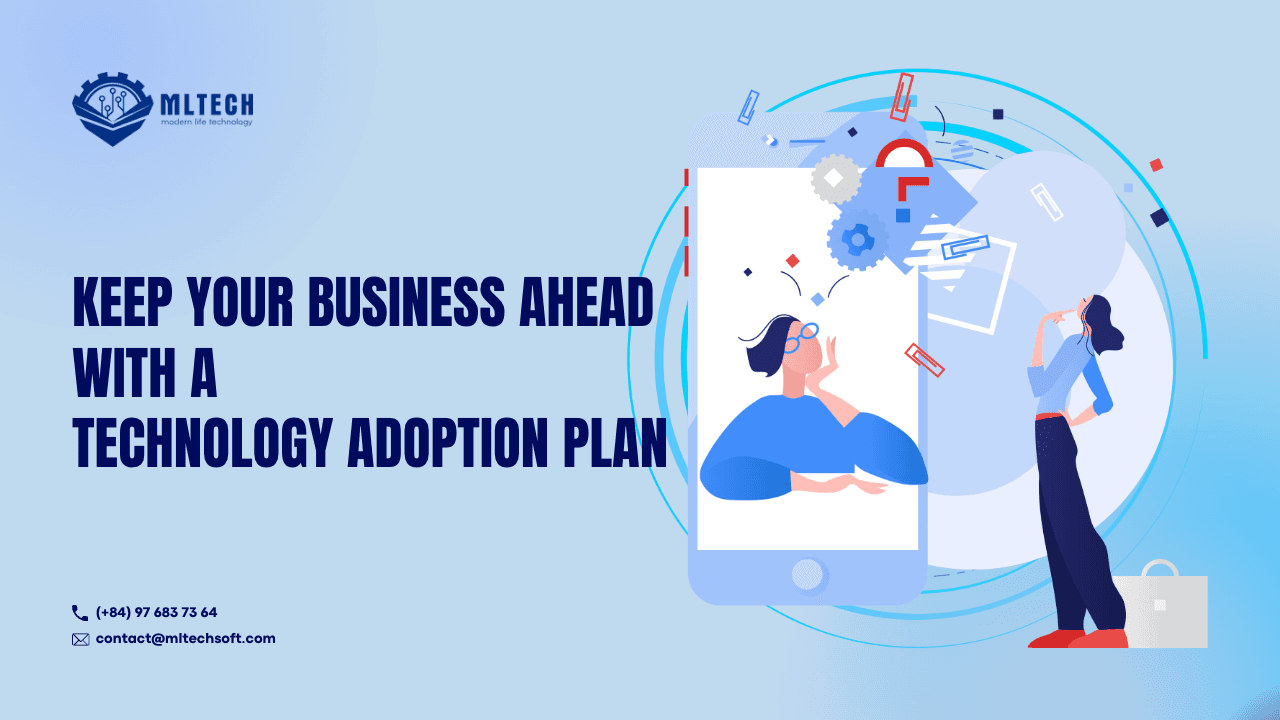Scroll down for more
Keep Your Business Ahead with a Technology Adoption Plan

The "technology acceptance curve" is a term used to define a sociological framework that describes how different people with different demographic and psychological characteristics adopt new technologies and innovative products and indicates whether they are supported. So it shows how different groups of people are embracing technology.
Assess your current technology infrastructure
By conducting an IT infrastructure assessment, organizations can identify and proactively address vulnerabilities, take steps to improve their IT infrastructure, and leverage IT solutions that increase employee productivity.
The need for assessing your current technology infrastructure before adopting new software technologies
It's not enough to just fill the gaps in your IT reputation. Consider the following red flags and hidden agendas: B. Technical staff in need of retraining or an outdated platform that some key people continue to covet. Consider some of the following questions when conducting an IT infrastructure assessment:
-
What indirect and hidden costs do these assessments reveal?
-
Will there be any maintenance, downtime, or training required when introducing a new platform or software?
-
What is the total cost of ownership of a legacy platform?
-
Do you have capacity or feature requirements that cannot be met with current IT technology? How much time is spent on day-to-day IT operations and more strategic projects?
-
What are your internal customers' experiences with your legacy platform? Which are redundant or manual workflows and which can be automated? How well does your service delivery meet their expectations?
-
Try to understand the total cost of ownership for each service or tool. For example, labor costs should include benefits, mileage, labor costs, etc.
How will changes in IT architecture affect corporate culture? What are the obstacles to these changes?

Tools and techniques to assess your technology infrastructure
SWOT analysis and PEST analysis are two methods companies use to plan through research. PEST analysis refers to the political, economic, social, and technological factors that affect the business environment. A SWOT analysis relates strengths, weaknesses, opportunities, and threats.
SWOT analysis
To summarize an IT SWOT analysis, horizontally align internal factors (strengths and weaknesses) and external factors (opportunities and threats), and clearly identify beneficial factors (strengths and opportunities) and harmful factors (weaknesses and threats).
IT audits
An IT audit is the process of evaluating and examining an organization's IT infrastructure, policies, and operations. It covers a wide range of software applications, security systems, operating systems, and more. IT audits are essential to ensure systems are not vulnerable to attack.
How do the results of a technology infrastructure assessment inform your software technology adoption plan?
Technology-assisted questions allow students to express more complex thinking and share their understanding of the material in ways that are difficult to assess using traditional methods.
Identify your business goals and objectives
Like any commercial business, IT companies have short-term and long-term business goals such as survival, profit maximization, sales and customer service, and economic growth.
Executives who do not encourage employees and company leaders to adapt to new technologies can cause companies to fall from their current position. The company may not go out of business entirely, but the industry leader may lose profits and reputation.
Business goals and objectives that can be achieved through software technology adoption
Improved productivity
Productivity gains are defined as the process of getting more out of every hour of work. Improving productivity can take many forms, including: systems, software, infrastructure, machines
Increased revenue
Revenue is the amount of money your business makes and includes income from sales and additional income from bank interest or investments. Businesses can increase sales by increasing sales, adding other revenue streams, and increasing the amount of money each sale generates.
How can aligning your software technology adoption plan with your business goals and objectives help you achieve better results?
Aligning IT strategy with business goals guides decisions, informs, and keeps everyone on the same page working towards the same goals. IT systems that are selected and implemented in alignment with an organization's strategic plan are more likely to be valuable and well-used tools.
Research available software technologies
A computer-based application that transforms input into output to assist a user in one or more research tasks.
Adapting new technology makes it easier for organizations to become more effective and productive, but only if the people in the organization are actually making the most of the new technology.

Resources that can be used to research software technologies
Online reviews
Gartner Digital Markets has three brands of software review sites. Capterra, GetApp, and Software Consulting. These software review sites have strengthened Gartner's market position as a trusted source of information for buyers.
Vendor websites
A supplier portal, also known as a vendor portal, is a platform that enables companies to connect and collaborate with third-party vendors over the web.
How can conducting thorough research help you make informed decisions about which software technologies to adopt?
Business research helps identify opportunities and risks. It helps you identify the problem, and based on this information, you can make wise decisions to deal with the problem appropriately. It helps us better understand our customers and thus improve our communication with them and our stakeholders.
Develop your adoption strategy
What is a product adoption strategy? A product adoption strategy is a technique you can use to get your customers to recognize and use your product. A successful product adoption strategy will convince users not just to try it for the first time.
Adopting technology can reduce costs, increase productivity, save time, improve the customer experience, and more. Files are easier to retrieve and access, allowing the same company to save on storage costs and deliver a better customer experience.
Elements included in an adoption strategy
A timeline for implementation
An implementation schedule is a working document that lists the activities, who is responsible, and the estimated time to complete the tasks. It can also include costs, expected obstacles, and goals. Implementation processes vary by industry and organization.
A communication plan
A communication plan should define what information should be communicated, who should receive that information, when that information should be delivered, and where (email, social media, posts, etc.) Share or define how that communication is tracked and analyzed.
How can developing an adoption strategy help you ensure that the adoption process is successful and smooth?
Developing an effective user adoption strategy is critical to an organization's successful implementation of new technologies. This blog post will help you assess your company culture and existing technology stack, define clear goals, engage with stakeholders, develop a comprehensive training program, communicate and promote the benefits of new technologies, monitor progress and Iterations as needed, and ongoing support.

Test and Evaluate the Software Technology
Software testing is the evaluation of software against requirements gleaned from user and system specifications. Testing is performed at the phase level of the software development life cycle or at the module level of program code. Software testing includes verification.
Software testing is the process of evaluating and verifying that a software product or application performs its intended functions. The benefits of testing include avoiding bugs, reducing development costs, and improving performance.
Test and evaluate software technologies methods
Pilot programs
Pilot testing is a type of software testing performed by a group of end users before the software is deployed into production. In this type of testing, components of the system or the entire system are tested in real-time scenarios.
Usability testing
Usability testing is testing and evaluating a product or service with representative users. Typically, during testing, participants attempt to complete typical tasks while observers watch, listen, and take notes.
How can testing and evaluating the software help you identify and address any issues before they impact the entire organization?
Testing is important as it detects defects/bugs before delivery to customers to ensure software quality. This makes the software more reliable and user-friendly. Thoroughly tested software ensures reliable and powerful software operation.

Train and Support Users
End-user training improves overall employee/user productivity. Productivity increases faster when all end users work in sync. End-user training delivers value across your business. Synchronizing all your users will help you build better profiles and get results more easily.
When deploying or creating new software, training helps users adapt to changing roles and adding new team members or vendors, while support helps end users avoid problems from the start.
Having enough knowledge and skills to get good results from the best software increases motivation and the desire to keep learning. These elements are essential for a successful professional career.
Training and support resources
Online tutorials
One of the biggest advantages of online learning is flexibility. Courses are self-paced, allowing users to complete tasks within a specific time frame. Participants access lessons through a learning management system (LMS) and follow instructions to complete the material.
User manuals
The instruction manual tool is online manual creation software that allows you to create instruction manuals and instruction manuals for products and services online. It offers complete customization capabilities that allow you to edit, create, and style the guide's content according to your specific needs.
How can providing training and support help ensure that users are able to effectively use the software technology and achieve the desired business outcomes?
Training and development helps companies attract and retain top talent, increase job satisfaction and morale, increase productivity, and generate more profits. Additionally, companies with actively engaged and engaged employees have 41% lower absenteeism and 17% higher productivity.
Measure and evaluate the results
The process of finding the properties and sizes of physical objects is called measuring. Evaluation, on the other hand, is a continuous process of quantification and qualitative interpretation based on value judgments.
Technology adoption is a key concept for business and organizational change. They must develop the ability to adapt to new technologies in their day-to-day processes so that they can effectively create new work models, develop new skills, and improve business performance.
Measure the effectiveness of the adoption plan
Percentage of new users compared to all users, whether it's a product or a specific feature. For example, if you have 22 new users this month and the total number of users is 200:
Adoption rate is 22/200 x 100
You can calculate it daily, weekly, monthly, or yearly.
ROI
Return on Investment (ROI) is a calculation of the monetary value of an investment relative to its cost. The formula for ROI is:
(Benefit minus Cost) / Cost
If you made $10,000 with $1,000 of effort, your return on investment (ROI) would be 0.9 or 90%.
How can ongoing evaluation and adjustment help ensure that your software technology adoption plan continues to meet your business goals and objectives?
How can you improve user adoption within your company?
- User Adoption Strategy #1: Check your needs
- User Adoption Strategy #2: Turn new technology releases into events.
- User Adoption Strategy #3: Set up a pilot program.
- User Adoption Strategy #4: Sponsor a rewards program.
Conclusion
If you suspect your system has been compromised, you should take immediate action to contain the damage and prevent further access to your data. This includes changing passwords, revoking user access, and taking systems offline until properly secured.
Continuous monitoring and updating of systems and software can protect your business from data breaches and other security threats.
Get our blog
Want the latest and greatest from our blog straight to your inbox? Chunk us your details and get a sweet weekly email.
Read more in our blog

Project Management
The Impact of Dynamic Pricing on Customer BehaviorExplore the impact of dynamic pricing on customer behavior and learn how to implement effective pricing strategies.

Project Management
Focus in Scrum: Keeping Your Team on TrackDiscover effective strategies to maintain focus within your Scrum team, overcome common challenges, and boost productivity.

Project Management
Key Metrics for Mobile App SuccessDiscover the essential metrics for mobile app success, from user acquisition and engagement to monetization and performance.
MLTECH SOFT